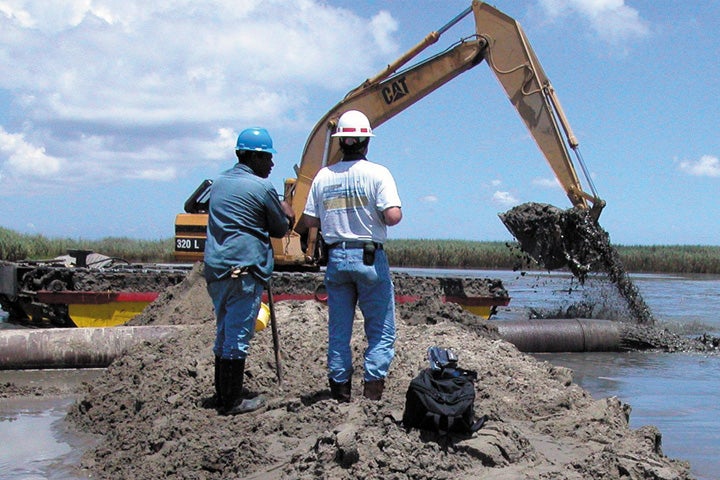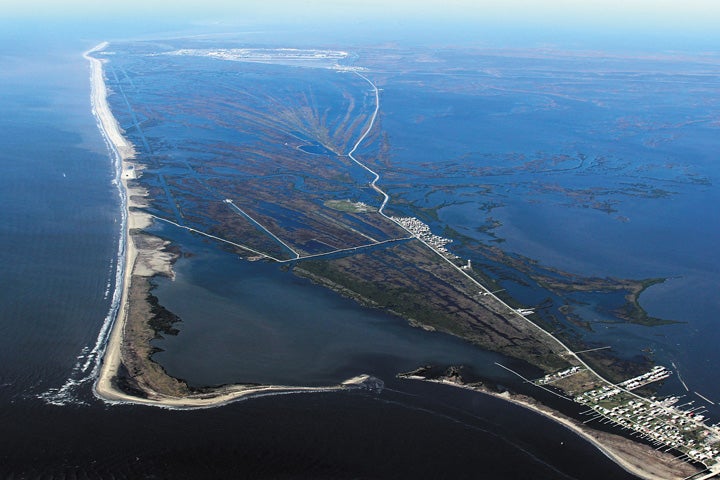Ensuring a Strategic and Sustainable Restoration Effort
The oil spill settlement provided an infusion of dollars to jumpstart restoration in Louisiana that has enabled the state to make significant progress on key Coastal Master Plan projects. But the settlement dollars will not be enough, which means we need a longer-term strategy for additional funding for the Louisiana Coastal Master Plan.
Stakeholders and decision-makers across the Gulf states should coordinate on restoration spending strategies for different funding streams during the near and long term.
Stakeholders and decision-makers across the Gulf states should coordinate on restoration spending strategies for different funding streams during the near and long term.
With roughly $12.8 billion remaining of the $16.67 billion total available for restoration across the Gulf, there is much work left to do.
Decision-makers across funding streams should develop a comprehensive strategy and long-term vision for Gulf health, in order to guide wise spending of remaining funds.
The state of Louisiana should identify sustainable funding beyond the term of the oil spill settlement.
The state of Louisiana should identify sustainable funding beyond the term of the oil spill settlement.
In addition to $6 billion in oil spill settlement funds, Louisiana has dedicated state resources and its share of offshore oil revenues to implement the Coastal Master Plan. However, these funds together will not be enough to complete the projects laid out in the Coastal Master Plan in entirety. To continue this important work, and sustain a delta that feeds and fuels the nation, the state of Louisiana must identify sustainable funding beyond the term of the settlement to complete as many synergistic, beneficial land-building and sustaining projects as possible.
Louisiana should continue to lead on restoration plans and policies that connect the long-term health of the Mississippi River Delta with the rest of the Gulf region.
Louisiana should continue to lead on restoration plans and policies that connect the long-term health of the Mississippi River Delta with the rest of the Gulf region.
The Coastal Master Plan was developed prior to the spill, but the oil spill has helped to guide and simplify Louisiana’s decision-making with funds. The plan is a visionary blueprint that prioritizes a suite of project types working together for maximum benefits. Louisiana should share lessons learned from its restoration and oil spill recovery efforts with other states around the nation.

In the 10 years since the oil spill considerable progress has been made on project planning and implementation. There are currently 24 restoration projects that have been completed, are in construction or are currently moving towards implementation using settlement money.
Utilizing Science and Performing Restoration the Right Way
Restoration to address oil spill injuries and create a healthy, more sustainable future for the Gulf of Mexico requires planning and investment in a suite of restoration projects that work together to create large-scale and long-term benefits. Since Louisiana was at the heart of the oil spill (and restoration in Louisiana is key to restoring long-term health to the Gulf), it is critical that restoration projects in the Mississippi River Delta are implemented efficiently and without delay so that their benefits can be realized.
In 2020 and beyond, state and federal agencies should efficiently advance projects that offer maximum benefits based on the best available science, and stay on track to meet specific milestones.
In 2020 and beyond, state and federal agencies should efficiently advance projects that offer maximum benefits based on the best available science, and stay on track to meet specific milestones.
River Reintroduction into Maurepas Swamp Project: This restoration project would divert fresh water and some sediment into the Maurepas Swamp to increase the long-term health and resilience of one of the largest remaining forested wetlands on the Gulf Coast. While this area was not directly impacted by the oil spill, this restoration project would contribute to overall Gulf ecosystem health by helping sustain approximately 45,000 acres of productive wetlands.
Mid-Breton Sediment Diversion: This large-scale restoration project will divert sediment-laden river water from the Mississippi River east into Breton Sound to build new land and sustain 16,000 acres of wetlands over 50 years.
Barataria Basin Habitat Restoration Plan: This strategy outlines three projects working together: the Mid-Barataria Sediment Diversion, the Large-Scale Barataria Marsh Creation Project, and the Spanish Pass Ridge Restoration that are all being considered for funding using oil spill funds. If constructed, these projects will work together to provide long-term, ecosystem level benefits to the Barataria Basin, one of the most heavily oiled coastal areas during the spill.
Science programs across the Gulf should connect available research dollars to restoration processes already underway, to ensure that science funds help to inform and improve outcomes of Gulf ecosystem restoration.
Science programs across the Gulf should connect available research dollars to restoration processes already underway, to ensure that science funds help to inform and improve outcomes of Gulf ecosystem restoration.
The NOAA RESTORE Science Program, the Centers of Excellence, the NAS Gulf Research Program, the NRDA dollars set aside for adaptive management and monitoring, and other science/research programs across the Gulf need to communicate and coordinate to best leverage all available research dollars, to inform restoration and to measure restoration success.
We have an opportunity now to set up thorough and robust monitoring and adaptive management programs and protocols that can serve as a model for future restoration programs. This monitoring and adaptive management can also be vital for the operation of ecosystem-scale, keystone restoration projects such as sediment diversion projects, which would be operated differently throughout the year to take advantage of river and basin conditions to maximize land-building.
As projects move forward and generate monitoring and performance data, the information should be standardized and centrally stored to promote efficiency and coordination.
As projects move forward and generate monitoring and performance data, the information should be standardized and centrally stored to promote efficiency and coordination.
Through the Natural Resources Damage Assessment process, oil spill-related science programs, and subsequent restoration efforts, an enormous amount of new data and science is being generated in the Gulf of Mexico region that can inform restoration needs and drive scientific inquiry in the region for years to come.
Robust monitoring that uses standard protocols and accessible, transparent data management is crucial in order to allow operational decision-making to be continually fine-tuned based on current data. This data must be shared so that the public, scientists and others are all seeing the same information that is being used for decision-making.
Engaging Communities for a More Resilient Future
From oil spills to hurricanes, Louisiana’s coastal communities have been at the forefront of disasters that have caused flooding, economic disruption, resource constraints, employment insecurity and population shifts. At the same time, these disasters have increased communities’ risks and vulnerability to impacts from climate change like sea level rise, hurricanes and extreme weather.
To meet these challenges, we must go beyond the status quo and seek innovative solutions. Ahead of the national curve in other areas, the state of Louisiana has already deployed awareness and engagement strategies that go beyond the typical public comment processes, cultivating a more informed and active public. However, the future holds many more important opportunities to build on that community engagement work to ensure the long-term success of restoration and adaptation programs.
From restoration planning to project implementation, state and federal agencies should improve the stakeholder engagement process.
From restoration planning to project implementation, state and federal agencies should improve the stakeholder engagement process.
Having well-informed communities and accessible engagement processes is a fundamental step in successful restoration and resilience initiatives. Raising awareness and growing leadership cannot be relegated to regulatory-required public comment processes. Sustained outreach that is often done on the terms of community stakeholders is critical to growing widespread support for the massive job of restoring our coasts and building resilient communities.
Workforce development, procurement strategies and coastal restoration should play an integral role in benefitting local and regional economies.
Workforce development, procurement strategies and coastal restoration should play an integral role in benefitting local and regional economies.
Guaranteed annual investments in coastal restoration in Louisiana over the next decade can truly benefit local and regional economies, but foundational work is needed to ensure those consistent investments provide maximum benefits. Through workforce development, residents of local communities can be prepared with the skills necessary to compete for these jobs and to support a meaningful and equity based “restoration economy.”
Local community colleges and universities are already offering restoration training programs at a variety of skill levels, and the jobs that flow from this work are becoming more clearly defined.
State and local officials and agencies and nonprofits must coordinate to tie together procurement strategies and local training initiatives targeted to workforce needs, equity, small business and Disadvantaged Business Enterprises, to ensure that the restoration economy truly lifts the coastal communities.
State and federal agencies should innovate fisheries management so fishers can adapt to a wider range of environmental conditions, such as the likelihood that an increasing amount and frequency of Mississippi River water will flow through the Bonnet Carre Spillway.
State and federal agencies should innovate fisheries management so fishers can adapt to a wider range of environmental conditions, such as the likelihood that an increasing amount and frequency of Mississippi River water will flow through the Bonnet Carre Spillway.
The opening of the spillway is just one of the many challenges that fishers will likely encounter in the years ahead. Continued land loss, seafood prices, and coastal restoration and flood protection projects all have potential consequences for members of the seafood industry.
Recently, the Louisiana Seafood Future (LSF) effort was led in partnership by CPRA, Louisiana Department of Wildlife and Fisheries, and Louisiana Sea Grant, in order to gain a better understanding of the challenges that fishers are facing and to document how industry members may keep their businesses profitable and sustainable in spite of those challenges.
The adaptation strategies highlighted in the LSF effort require analysis to determine applicability and viability so that strategies may be shelf-ready when and if the anticipated challenges present themselves, and should funding be made available.

Conclusion
Ten years after the most devastating ecological tragedy to hit the Gulf of Mexico happened, restoring the Mississippi River Delta and its surrounding coastline isn’t just about recovering the wildlife and habitats harmed from the 2010 oil spill; it is ultimately about the opportunity to envision a more sustainable and resilient delta for future generations. The people of coastal Louisiana should be central to developing that vision, working together with the state, agencies and the NGO and science communities to ensure that the right projects are selected to move forward; that billions of settlement dollars are spent in ways that maximize restoration potential; and that the economies and ecosystems of the coast continue to thrive in decades to come.